This post may contain affiliate links. Please read our disclosure policy.
Eggs in purgatory (aka uova in purgatorio) are Italian baked eggs in tomato sauce perfect for enjoying as a hearty breakfast/brunch or even lunch! All you need for these Italian eggs is a handful of ingredients and one pan for a low-calorie, gluten-free, budget-friendly, meat-free meal!
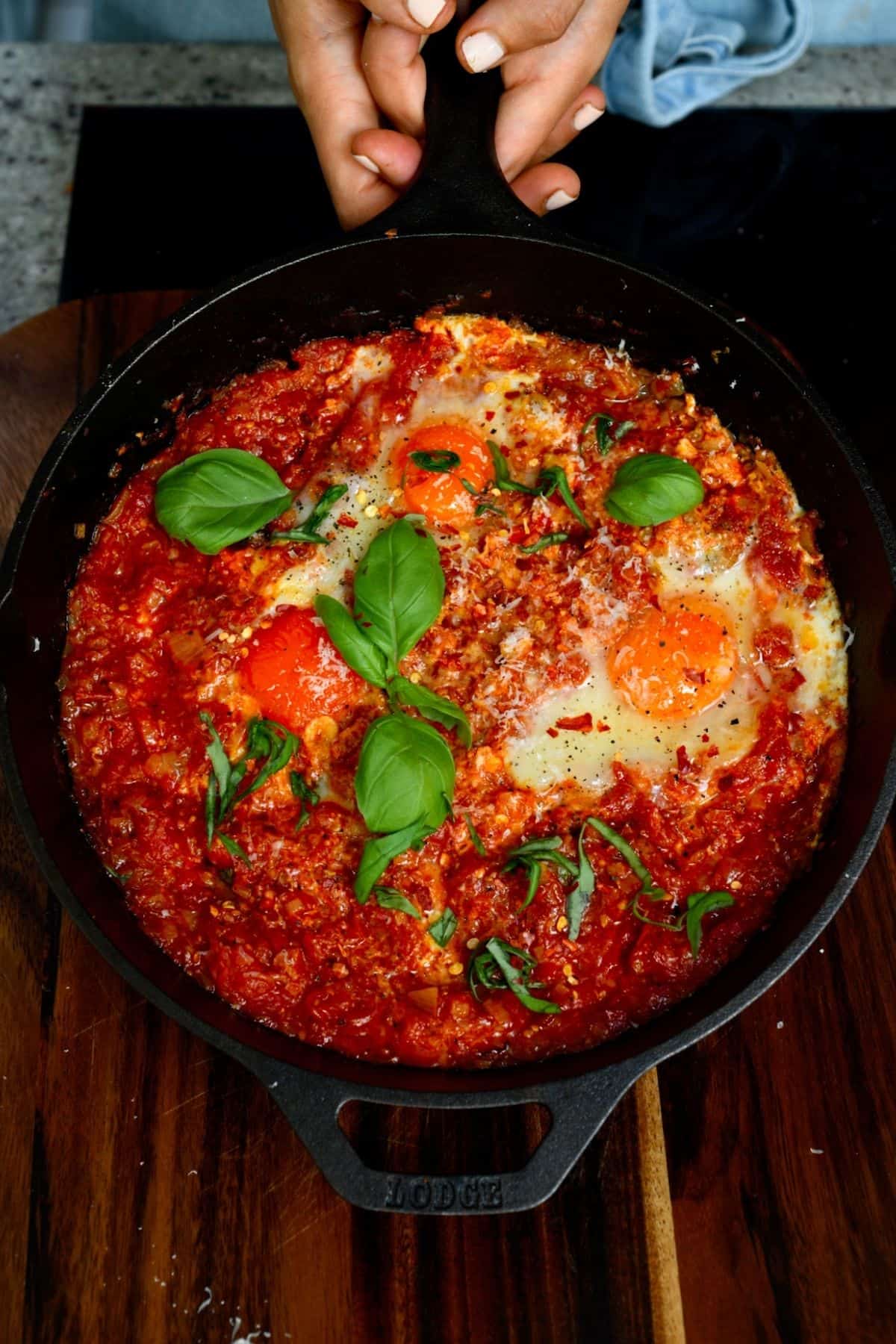
While I love a super light breakfast as much as the next person, sometimes I’m really in the mood for something that’s cozy and hearty. That’s where dishes like eggs in purgatory (uova in purgatorio) shine!
This simple Italian baked tomato egg dish requires just one pan, a handful of simple and relatively inexpensive ingredients, and can then be enjoyed for breakfast, brunch, or even lunch/dinner! Since it’s so simple to prepare, it’s great for a last-minute meal, too!
This baked Italian eggs dish is perfect for the summertime when tomatoes are at their ripest (the perfect time for Italian Caprese salad and Tuscan Panzanella, too). You can even prepare the sauce in advance and store it in the fridge for several days or freezer for several months. When ready, heat it, add the eggs and cook to perfection. Top off with a little parmesan and fresh herbs and get ready for dipping, mopping, and smearing with lots of fresh bread! Delicious!
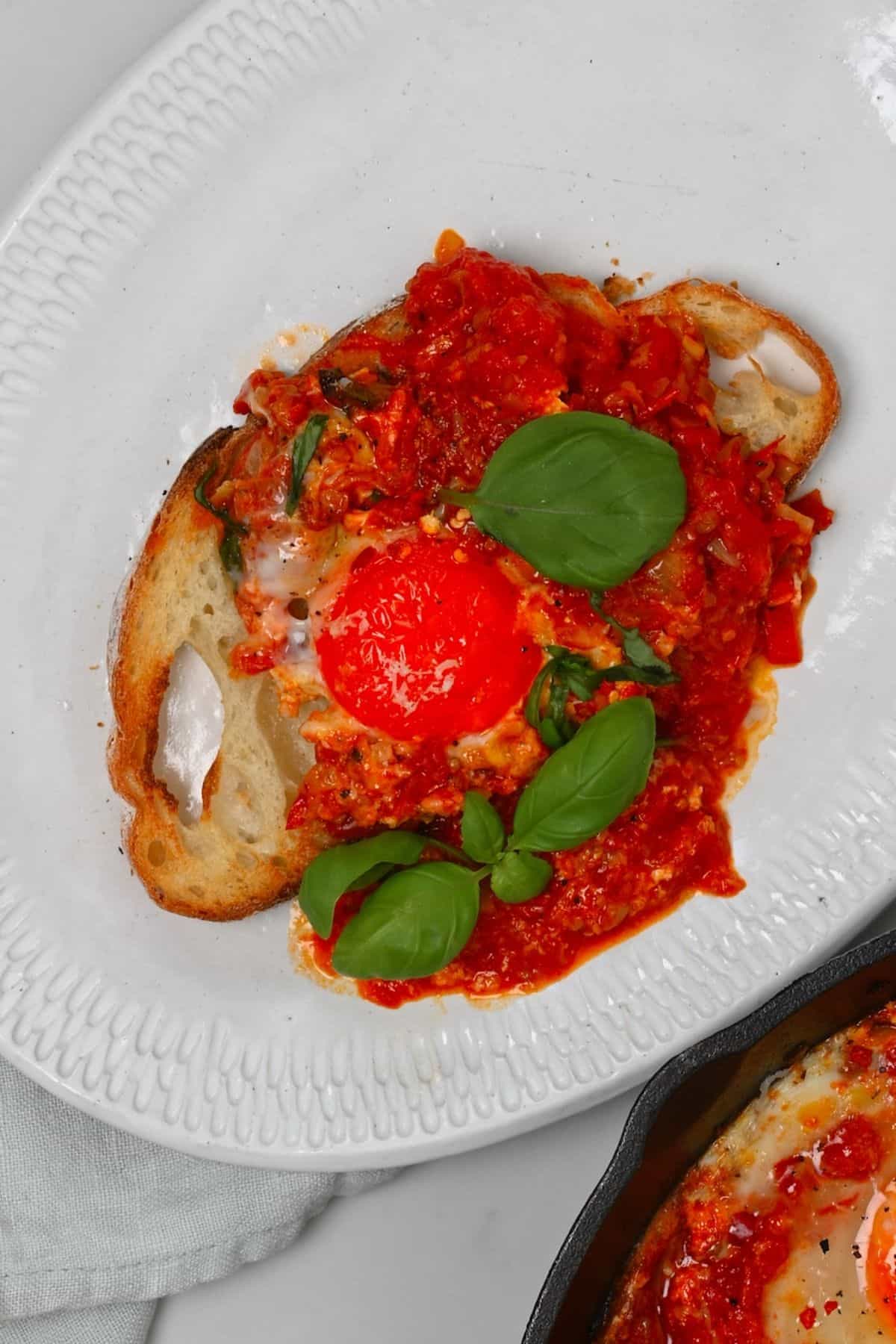
Want to save this recipe?
What are eggs in purgatory?
Eggs in purgatory aka Uova in Purgatorio or Uova All’inferno is an Italian dish, originally from Naples, of eggs baked in a tomato sauce (often spicy). There are several similar tomato baked eggs dishes out there, including Arabic shakshuka, Turkish menemen, and Andalusian huevos a la flamenco. However, this version is particularly simple (and yet flavor-packed), with simple seasonings and a focus on the tomatoes (no extra veggies) with the optional addition of anchovies.
As for its curious name, some say these Italian baked eggs in tomato sauce are named that way as the eggs floating among the tomato sauce were meant to represent “souls” stuck in purgatory (the space between heaven and hell).
A family friend once told me that they believe the dish originated during lent when Catholics would avoid eating meat on particular days of the week, and the eggs would help make up for the protein (while remaining low-cost). Then again, I am not sure of the exact origins.
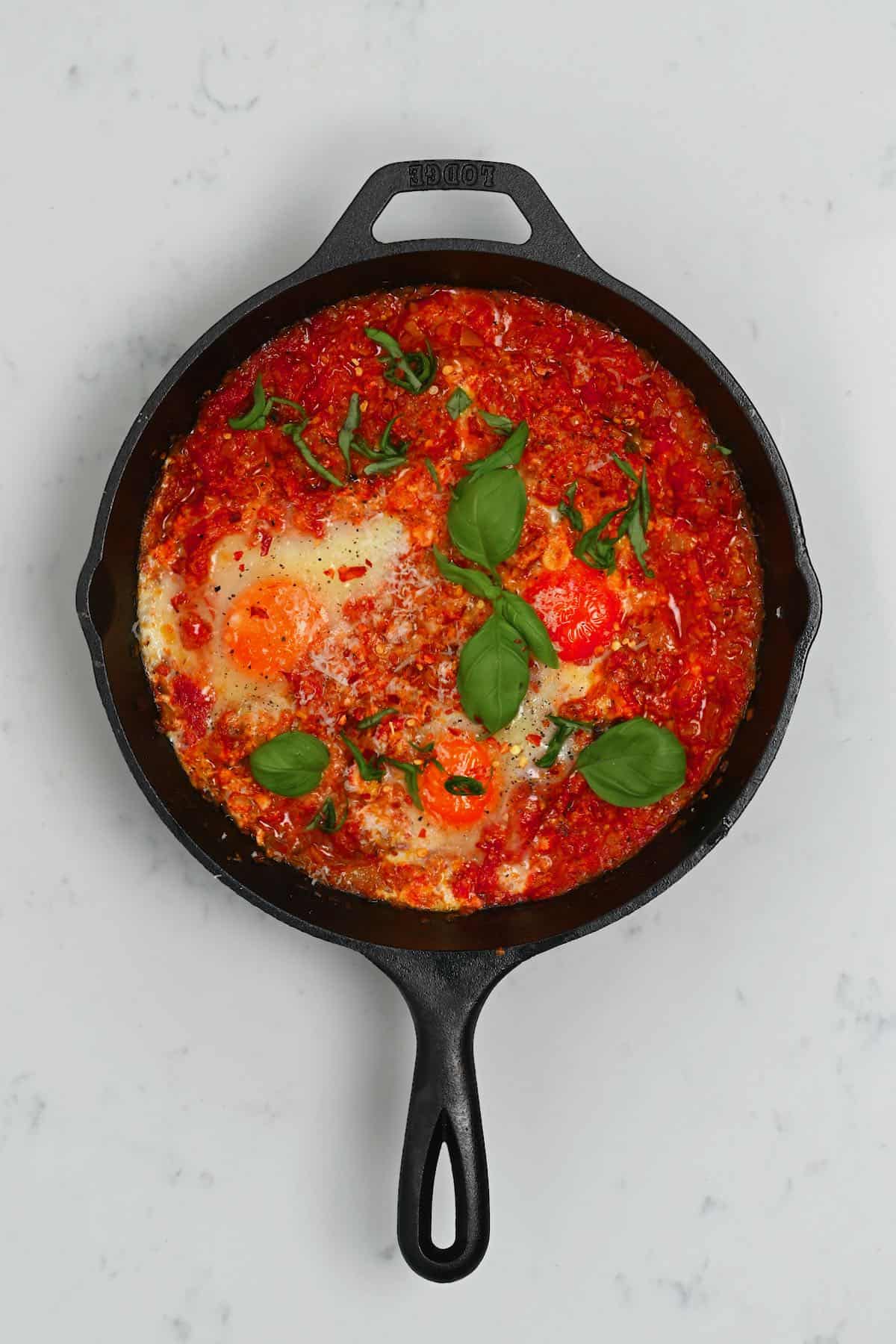
Once baked, the tomato sauce and eggs make for a rich and flavor-packed meal. Meanwhile, the yolks, which are always left runny in this house, are perfect for mopping up with bread along with the sauce (called “la Scarpetta” in Italian)!
For more eggy breakfast dishes, you might like these French baked eggs in oven, this sweet potato breakfast hash, savory oatmeal with fried egg, Mexican huevos rancheros, breakfast egg fried rice, tomato egg tortilla quiche, or mini breakfast tacos!
The Italian baked eggs ingredients
- Tomatoes: make sure to use the ripest, juiciest tomatoes you can find – Roma would work excellently, or vine-ripened, beefsteak, or heirloom. If it’s off-season, then you can use a high-quality tin of Italian tomatoes (like DOP “San Marzano” tinned tomatoes).
- Eggs: I used 3 eggs for this dish (one per portion). However, feel free to increase/decrease the amount based on how big your servings will be. For a “lighter” dish you could even use egg-white only (and save the yolk for custard or other recipes).
- Aromatics: I used a combination of onion (yellow) and garlic (adjust the amount to personal preference). I also added a fresh red chili for heat. Feel free to omit this if you’d like a mild version (alternatively, add a pinch of red pepper flakes or some harissa).
- Parmesan: Parmesan adds a lovely element of slightly tangy, salty flavor.
- Basil: I love the combination of basil with fresh tomatoes. Parsley is another, perhaps more traditional eggs in purgatory addition.
- Salt & Pepper.
- Oil: any neutral cooking oil will work – I use olive oil.
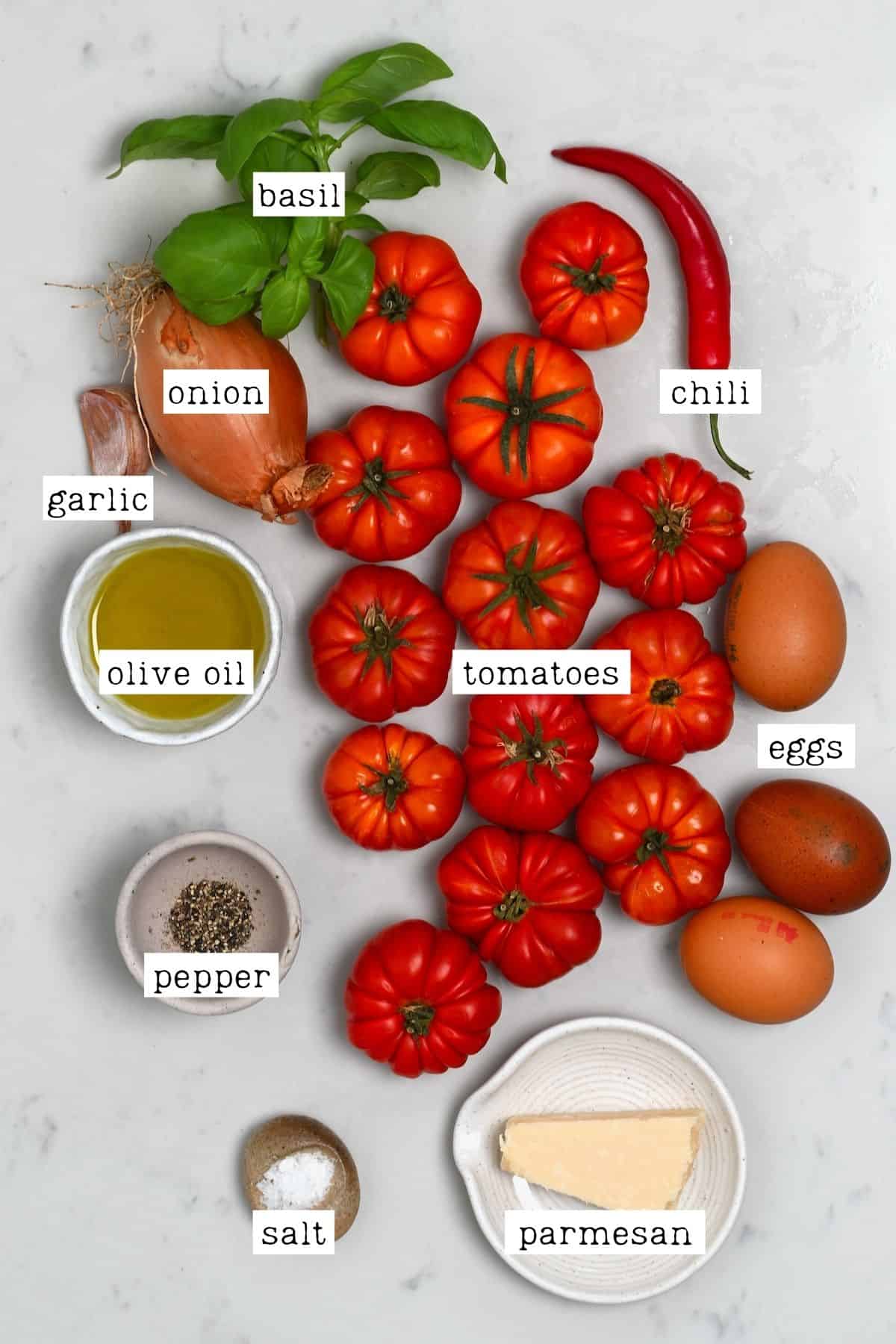
Optional add-ins
- Other tomato: to add extra depth to the tomato flavor you can add in additional tomato products like a little tomato puree or sun-dried tomatoes.
- Anchovies: these are a traditional addition to eggs in purgatory so feel free to add some if you like the taste. I recommend 2-3 anchovy fillets, finely chopped. The dish won’t taste super fishy but will have extra salty elements to it.
- Capers: alternatively, to keep this dish vegetarian, you could add some capers for a salty, tangy flavor addition.
- Herbs/Spices: there are several options to choose from including adding a little paprika, dried oregano, Italian seasoning, etc.
- Vegetables: peas are a common addition to Italian baked eggs in tomato sauce. Other veggies (like red/green peppers, corn, eggplant, zucchini, spinach/kale, olives etc.) would also work. But the dish will start becoming closer to my previously shared shakshuka recipe).
- Cheese: feel free to swap out the parmesan for another cheese like crumbled feta or creamy burrata/mozzarella.
- Pesto: add a swirl of fresh homemade Italian pesto to this dish to pack in tons of extra flavor.
- Vegan eggs in purgatory: you can make a similar dish, substituting the eggs for scrambled tofu and top with vegan cheese. You could also skip the egg entirely and use cooked chickpeas instead!
- Breadcrumbs: I’m not sure how “classic” this is but sprinkling some breadcrumbs over the top of the Italian baked eggs helps to add extra texture. Especially if broiled for a minute or so.
- Lemon: you can serve the Italian eggs in purgatory with wedges of lemon. The juice really brightens up the dish even more!
How to make eggs in purgatory?
Step 1: Chop the aromatics
First, finely chop the onion and mince the garlic. If you’re using one, then finely chop the chili at the same time, remove the ribs and seeds.
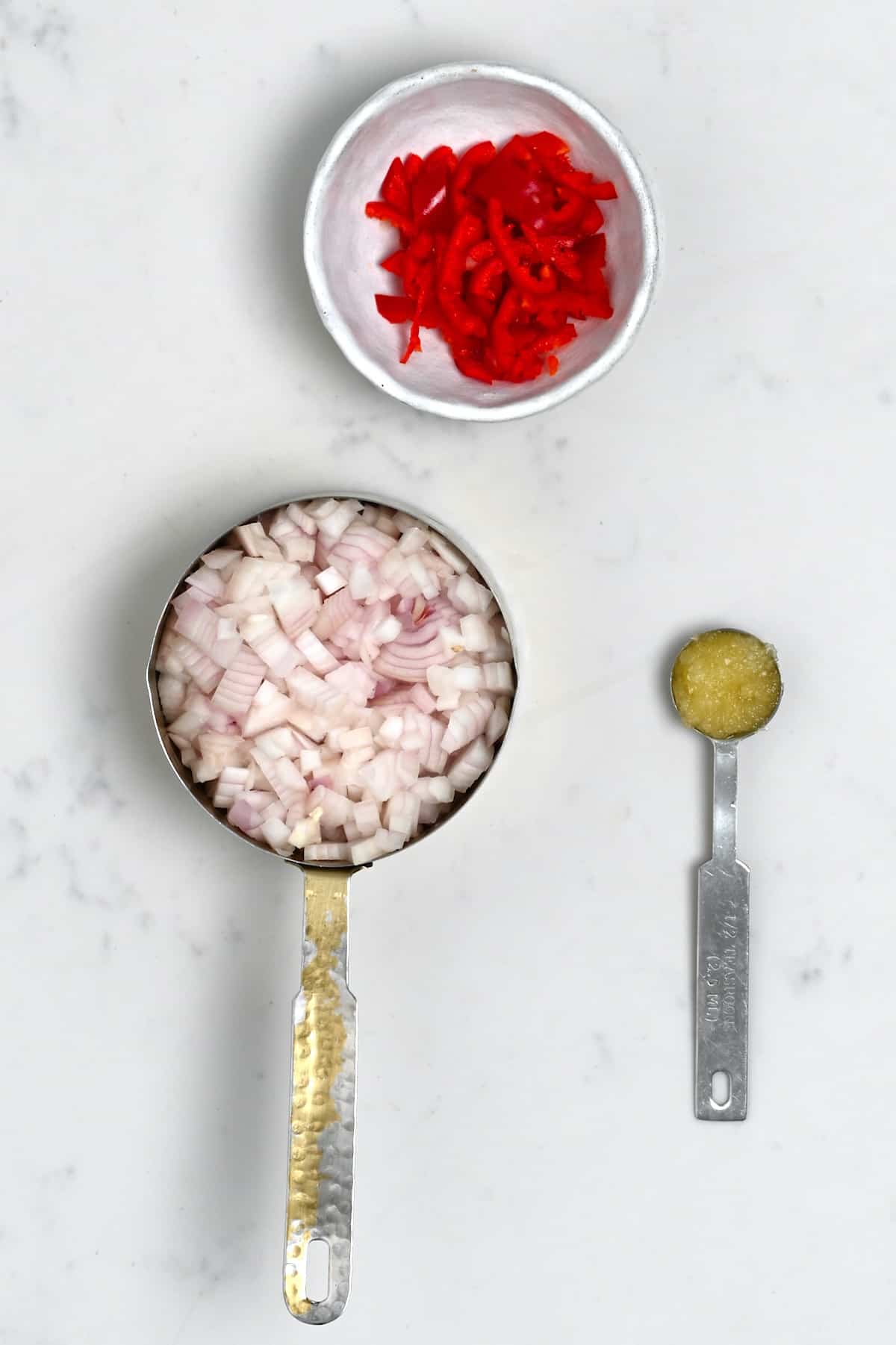
Step 2: Sauté the ingredients
Head up the oil in a large pan. Then add the onion and heat over medium heat, stirring constantly, until translucent (2-3 minutes). Then add the garlic, stir, and cook for a further minute.
Add the tomatoes and cook either on the stovetop or in the oven (make sure to use an oven-safe pan) until the tomatoes become tender.
I added the tomatoes whole, which takes a bit longer to cook. Alternatively, you can finely chop/mash them before adding them to the pan.
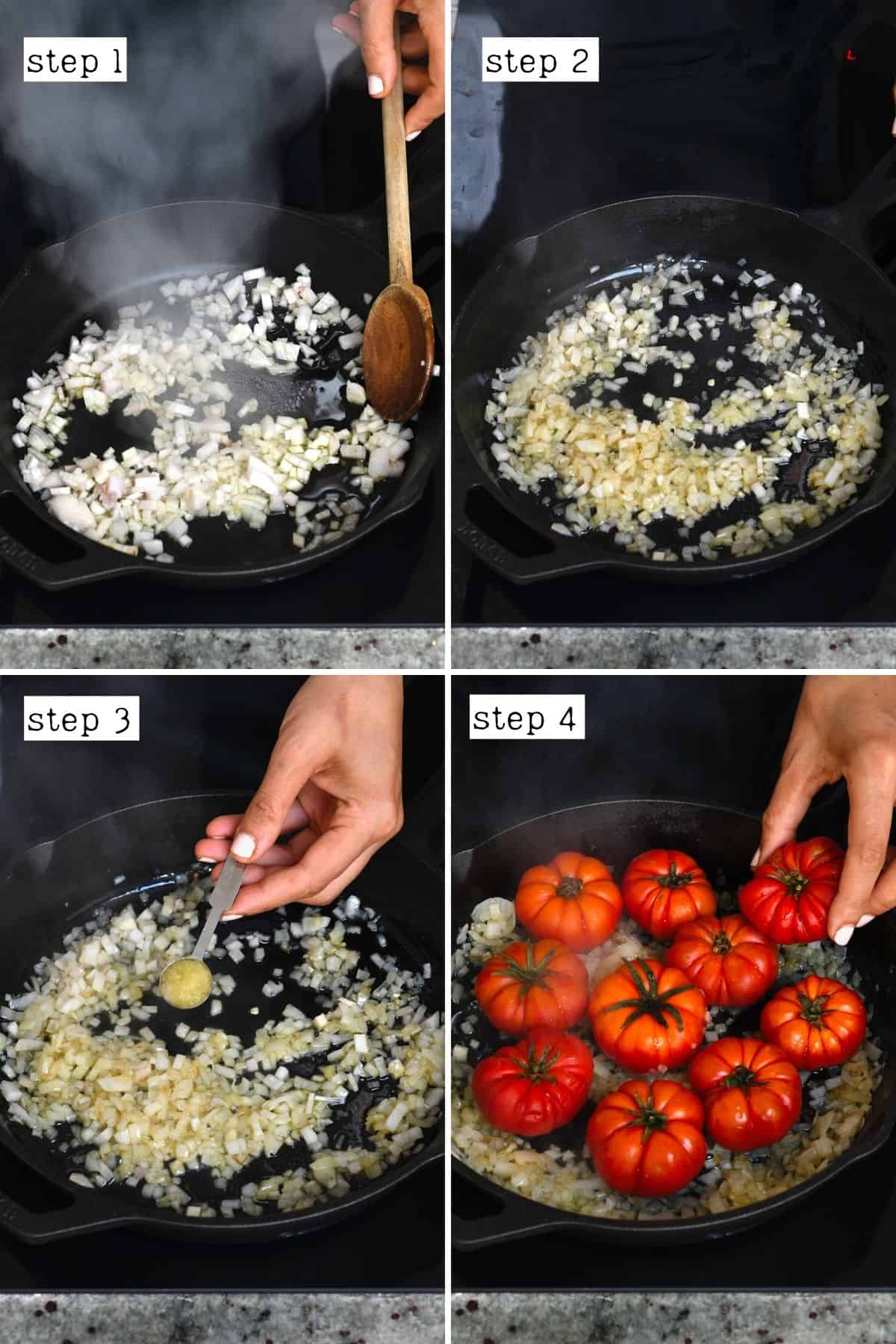
I baked them in the oven at 420ºF/215ºC for about 15-20 minutes.
Once roasted/cooked, the whole tomatoes will have released all their juice. Then they will be easily mashable with a potato masher/large fork. I also remove the stems and skins (optional) at this point.
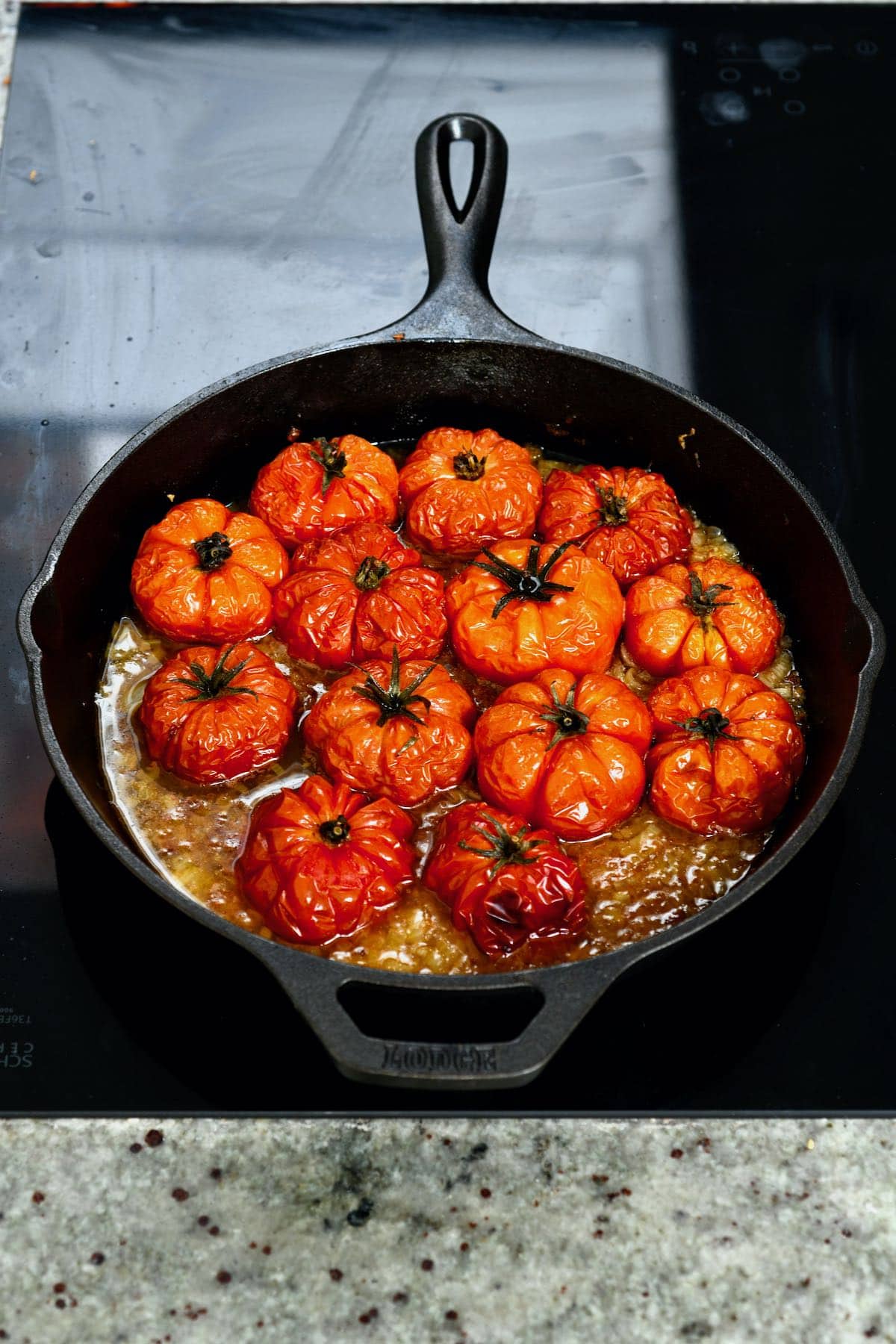
Finally, add the salt, pepper, chili, and a few basil leaves and stir. Allow the sauce to thicken and reduce, until it’s thick enough to create slight “wells” within the sauce.
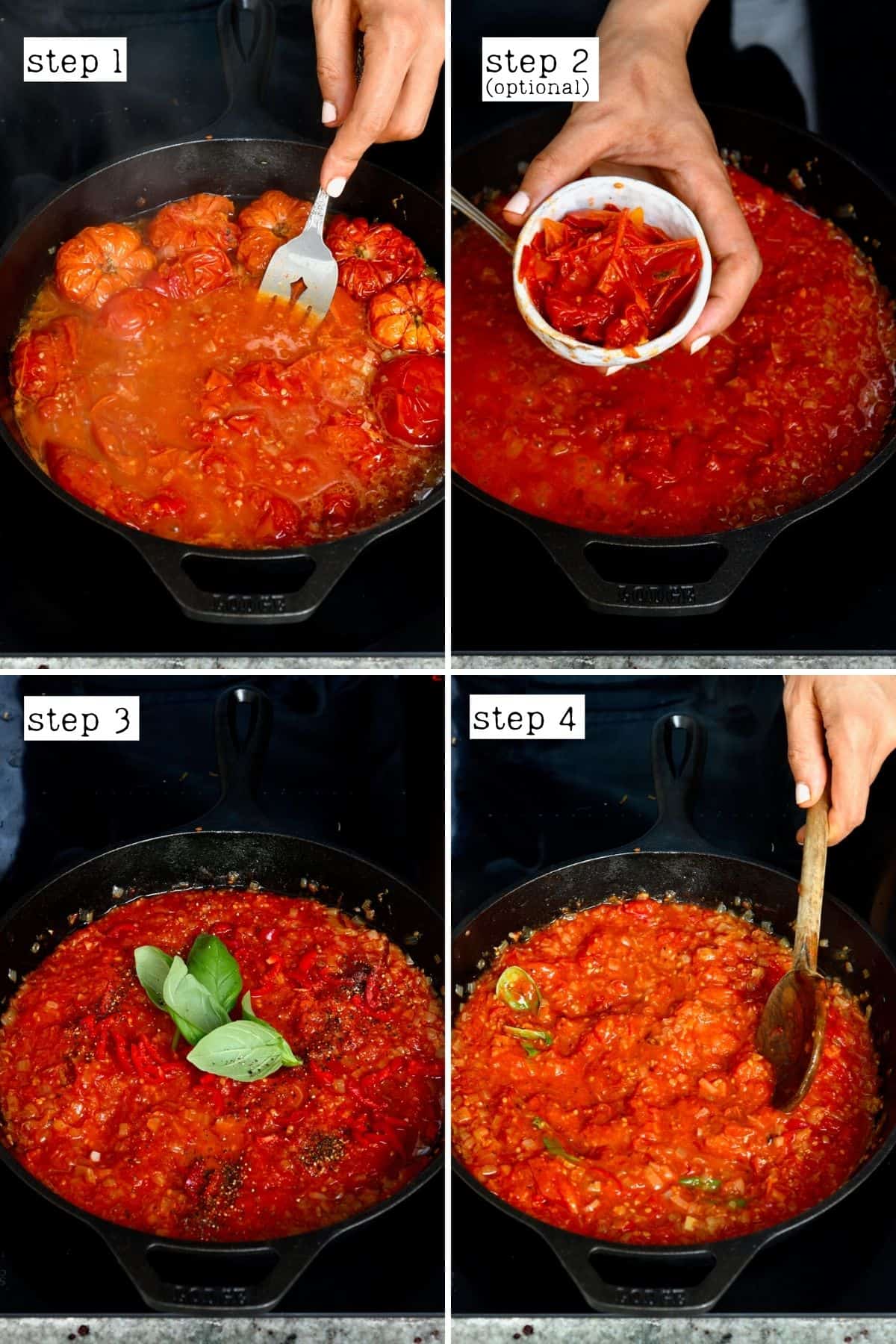
Step 3: Add the eggs
To add the eggs you can optionally create shallow wells for them to sit within. Alternatively, you can simply crack the eggs over the dish. Some people like to first crack the eggs into a bowl or spoon and then slowly lower them into the dish. I usually crack them directly into the pan.
Then transfer the skillet back to the oven and bake until your eggs are done to your preferred level. I like my whites cooked through and yolks soft.
If you’re having issues getting the eggs to cook to your desired level, you can pan-fry them separately. Then add them to the pan when cooked. You could also cook the dish on the stovetop over low heat, with a lid, until the egg whites are cooked.
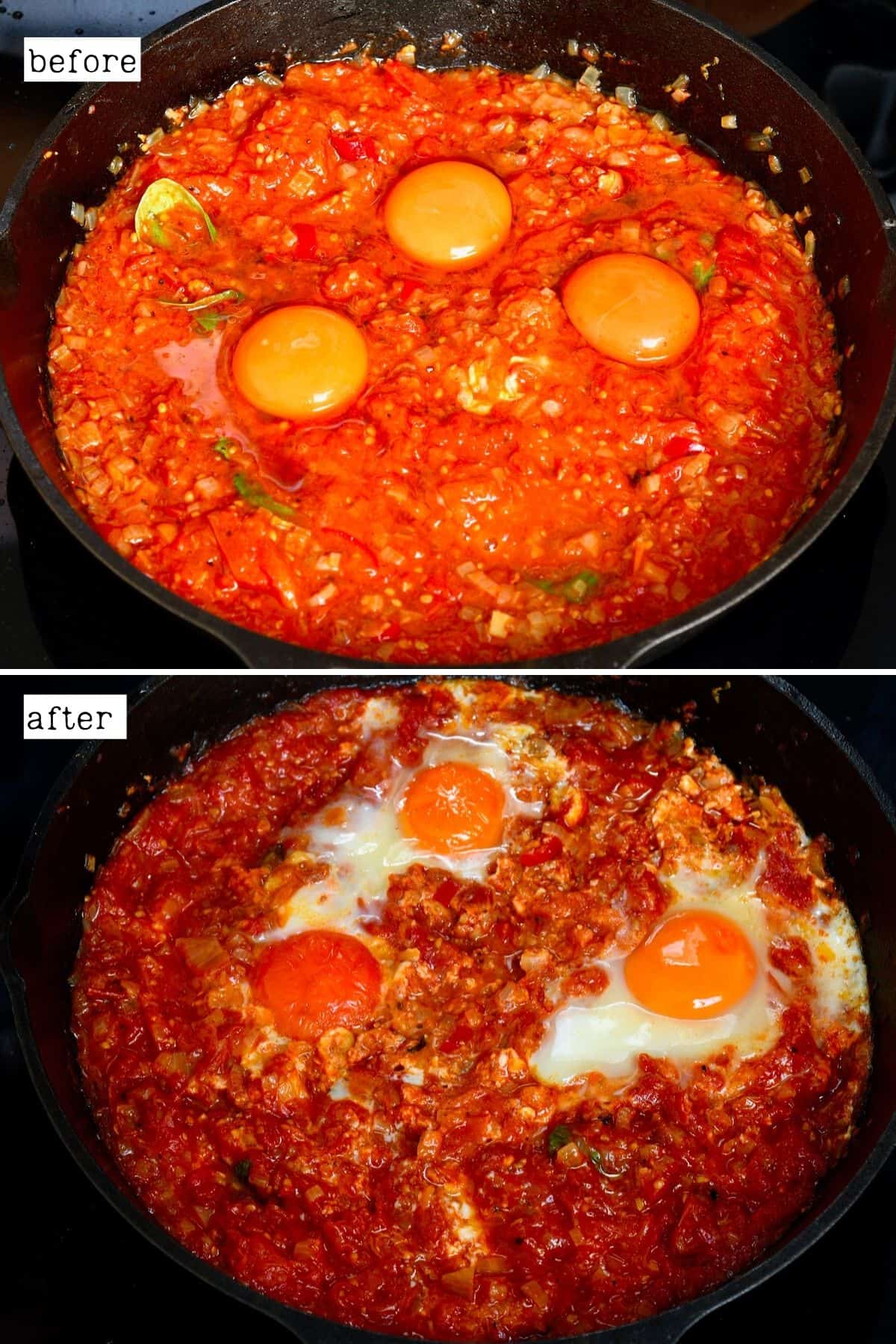
Once ready, top the tomato baked eggs with a little parmesan and some extra fresh basil and serve! Optionally drizzle with a little additional olive oil when serving.
How to serve
My favorite way to enjoy eggs in purgatory is with bread: crusty bread, naan, pita, soft pretzel, simit, or even served over a bagel – you can’t go wrong!
I recommend rubbing any crust bread with fresh garlic (as I do for bruschetta), for even more flavor.
Then enjoy the tomato baked eggs with your favorite breakfast drink like coffee, tea, or a glass of fresh orange juice!
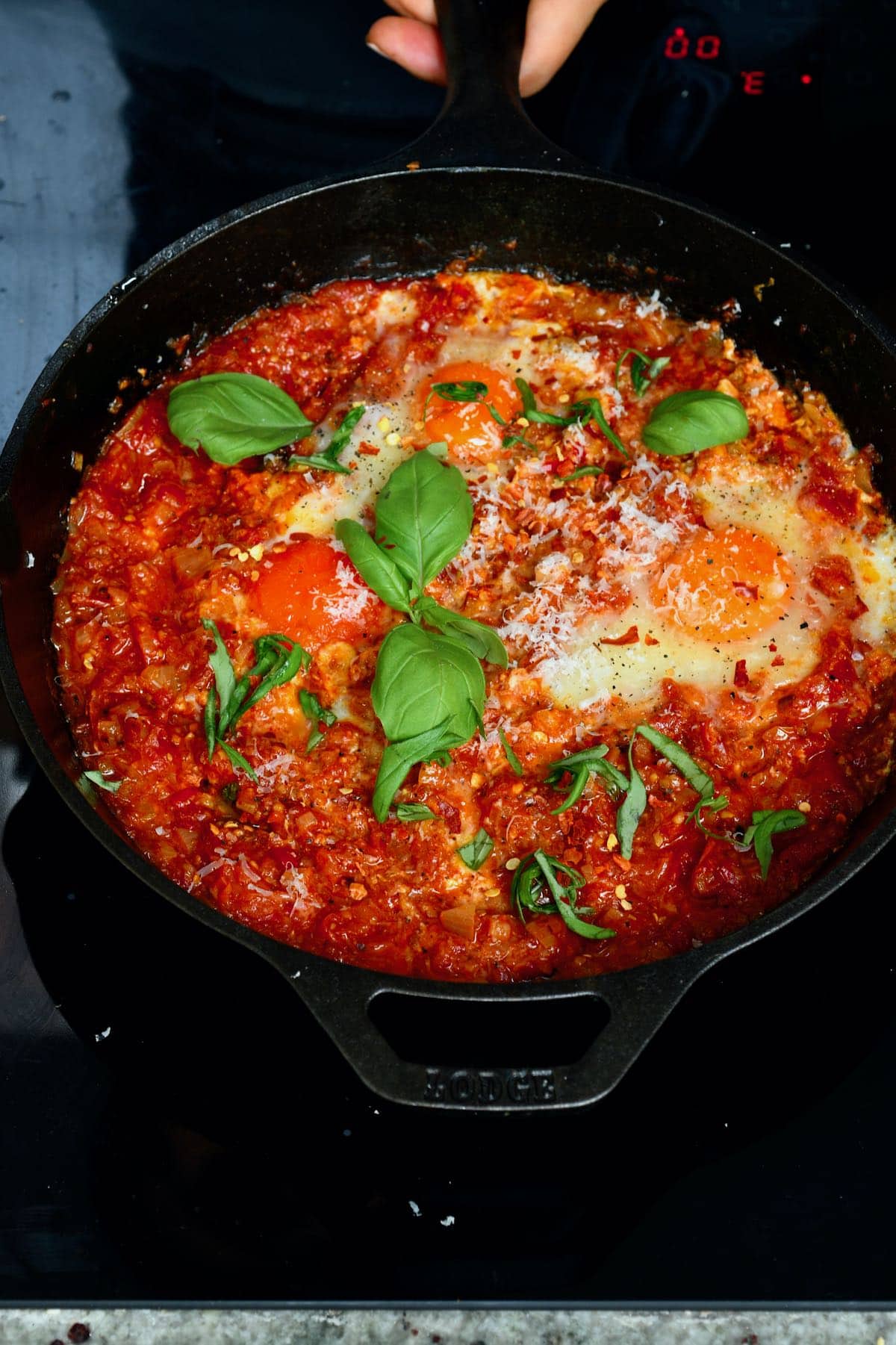
How to store
Make ahead: you can prepare the tomato sauce up to a day in advance and store it in the fridge until you’re ready to reheat, add the eggs, and finish cooking. You can also freeze the sauce for up to 3 months. I recommend doing so in portions so you can thaw just the right amount each time you crave this dish.
Store: while this dish tastes best fresh, the leftover tomato sauce will last up to three days in an airtight container in the fridge.
Either way, when storing, I recommend only doing so with the sauce and not the eggs.
Reheat: reheat the tomato sauce with a splash of water on the stovetop until simmering and then add the eggs and either bake or cover and cook until ready – then top with cheese and herbs and enjoy! Feel free to add a little salt and pepper to the top of the eggs.
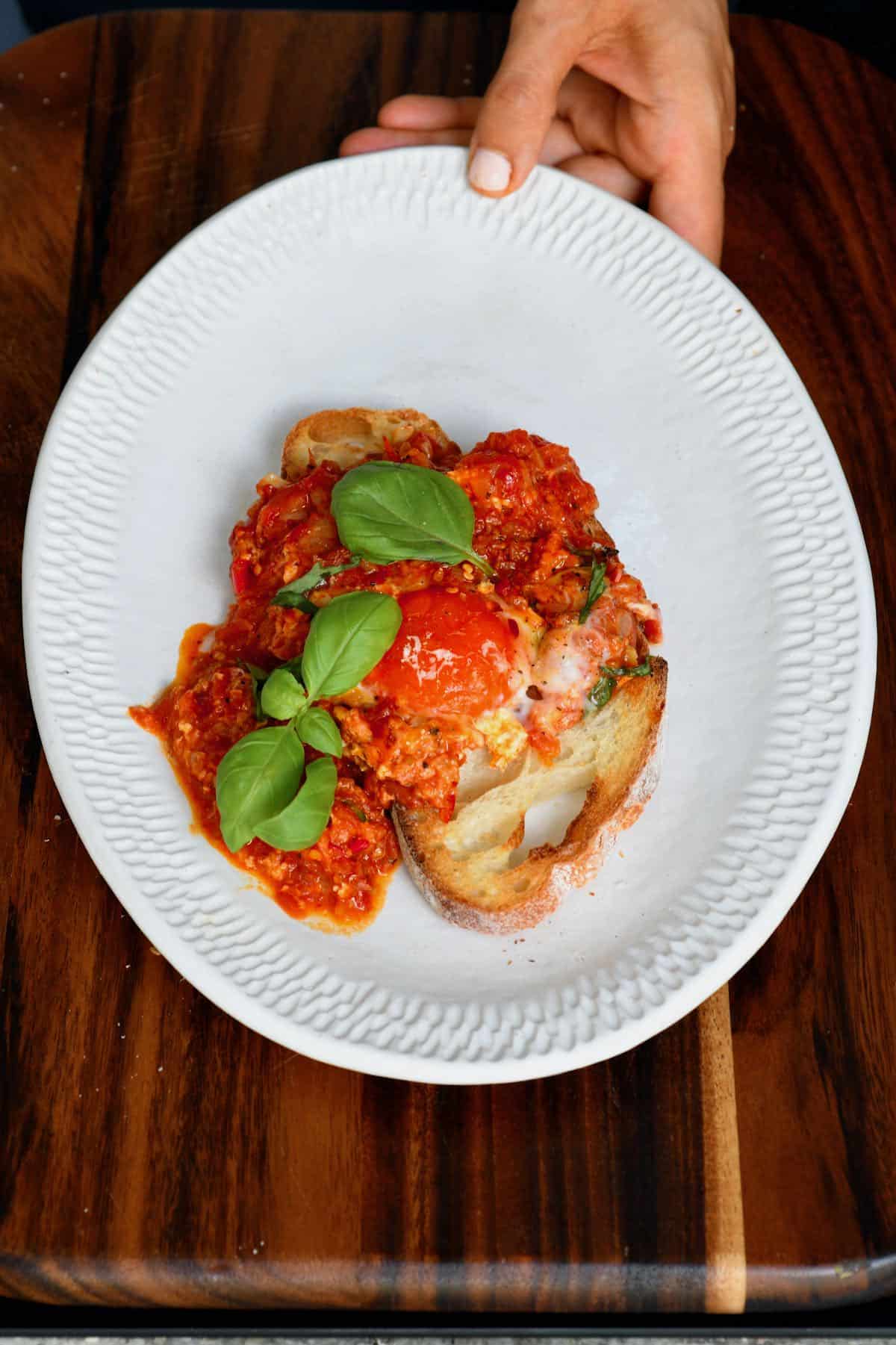
Recipe notes
- Using the best pan: I recommend using a pan that isn’t too large when making this dish. Otherwise, the sauce texture will be impacted, and you run the risk of burning the sauce/losing too much liquid. I used one that’s slightly larger than I usually would since I roasted the tomatoes whole (which will help retain the moisture). If you’re using pre-chopped/crushed tomatoes, though, use a pan that just about holds all the tomatoes when raw (it will cook down before the eggs are added).
- Using the leftover sauce: any leftover sauce can be used for another round of these Italian baked eggs OR as a simple sauce for pasta! I often like to use leftovers to make a “single-serve” portion. To do so, add the sauce to a small ramekin, topped with 1-2 eggs. Then bake (or Air Fry) for around 10 minutes (or until the egg white is fully cooked) then top with cheese and herbs.
- For the quickest version: use chopped rather than whole tomatoes on the pan. That way they will soften and reduce at the same time. When baking the tomatoes whole, you then need to mash them and further reduce the sauce before you can add the eggs.
- Cooking the eggs: if you’re worried about getting the eggs “just right” (fully cooked eggs but runny yolks), you can always pan-fry or even poach eggs separately then add them to the sauce when ready.
- Adjust the heat: the sauce is very adaptable. Omit the chili entirely or adjust the amount of spice to personal preference.
More breakfast and brunch recipes
- Quick and easy French toast (Brioche perdu)
- High-protein spinach crepes
- Strawberry cheesecake baked oatmeal
- Breakfast wrap in potato flatbread
- Aebleskiver Danish blueberry pancake balls
- 7+ breakfast quesadillas
- Creamy mushroom toast
- Homemade muesli
- One-Pan Vegetarian Full English Breakfast
- How to Make Fluffy Scrambled Eggs (With Butter | + Flavor Variations!)
If you try this Italian eggs in purgatory recipe, I’d love to hear your thoughts/questions below. Also, I’d appreciate a recipe card rating below, and feel free to tag me in your recipe recreations on Instagram Alphafoodie!
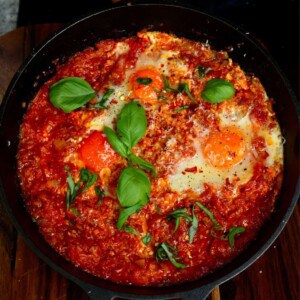
Eggs In Purgatory (Italian Baked Eggs)
Ingredients
- 26.5 oz tomatoes 10-13 medium; ripe, juicy tomatoes like Roma, vine-ripened, beefsteak, or heirloom
- 3 eggs
- 3.5 oz onion (1 medium sized)
- 1 garlic clove adjust to personal preference
- 0.42 oz chili (1 chili pepper or 1 tsp red pepper flakes/harissa paste; or omit)
- 2 Tbsp olive oil
- 1/2 tsp salt
- 1/4 tsp black pepper
- few sprigs fresh basil or parsley
Instructions
Step 1: Chop the aromatics
- Finely chop the onion and mince the garlic. If you're using one, then finely chop the chili at the same time, remove the ribs and seeds.
Step 2: Sauté the ingredients
- Head up the oil in a large pan. Add the onion and heat over medium heat, stirring constantly, until translucent (2-3 minutes). Add the garlic, stir and cook for a further minute.
- Add the tomatoes and cook either on the stovetop or in the oven (make sure to use an oven-safe pan) until the tomatoes become tender.I added the tomatoes whole, which takes a bit longer to cook. Alternatively, you can finely chop/mash them before adding them to the pan. I baked them in the oven at 420ºF/215ºC for about 15-20 minutes.
- Once roasted/cooked, the whole tomatoes will have released all their juice and will be easily mashable with a potato masher or just a large fork. I also remove the skins at this point (optional).
- Add the salt, pepper, chili, and a few basil leaves and stir. Allow the sauce to thicken and reduce, until it's thick enough to create slight "wells" within the sauce.
Step 3: Add the eggs
- To add the eggs you can optionally create shallow wells for them to sit within or simply crack the eggs over the dish. Some people like to first crack the eggs into a bowl or spoon and then slowly lower them into the dish, but I usually crack them directly into the pan.
- Transfer the skillet back to the oven and bake until your eggs are done to your preferred level. I like my whites cooked through and yolks soft.If you're having issues getting the eggs to cook to your desired level, you can pan-fry the eggs separately and add them to the pan when cooked. You could also cook the dish on the stovetop over low heat, with a lid, until the egg whites are cooked through.
- Once ready, top the dish with a little parmesan and some extra fresh basil and serve! Optionally drizzle with a little additional olive oil when serving.My favorite way to enjoy eggs in purgatory is with bread: crusty bread, naan, pita, soft pretzel, simit, or even served over a bagel – you can't go wrong!
How to Store?
- Make ahead: you can prepare the tomato sauce up to a day in advance and store it in the fridge until you're ready to reheat, add the eggs, and finish cooking. You can also freeze the sauce for up to 3 months. I recommend doing so in portions so you can thaw just the right amount each time you crave this dish.Store: while this dish tastes best fresh, the leftover tomato sauce will last up to three days in an airtight container in the fridge.Either way, when storing, I recommend only doing so with the sauce and not the eggs.Reheat: reheat the tomato sauce with a splash of water on the stovetop until simmering and then add the eggs and either bake or cover and cook until ready – then top with cheese and herbs and enjoy! Feel free to add a little salt and pepper to the top of the eggs.
Notes
- Other tomatoes: to add extra depth to the tomato flavor you can add in additional tomato products like a little tomato puree or sun-dried tomatoes.
- Anchovies: these are a traditional addition so feel free to add some if you like the taste. I recommend 2-3 anchovy fillets, finely chopped. The dish won’t taste super fishy but will have extra salty elements to it.
- Capers: alternatively, to keep this dish vegetarian, you could add some capers for a salty, tangy flavor addition.
- Herbs/Spices: there are several options to choose from including adding a little paprika, dried oregano, Italian seasoning, etc.
- Vegetables: peas are a common addition. Other veggies (like red/green peppers, corn, eggplant, zucchini, spinach/kale, olives, etc.) would also work but the dish will start becoming closer to my previously shared shakshuka recipe).
- Cheese: feel free to swap out the parmesan for another cheese like crumbled feta or creamy burrata/mozzarella.
- Pesto: add a swirl of fresh homemade Italian pesto to this dish to pack in tons of extra flavor.
- Vegan eggs in purgatory: you can make a similar dish, substituting the eggs for scrambled tofu and top with vegan cheese. You could also skip the egg entirely and use chickpeas instead!
- Breadcrumbs: I’m not sure how “classic” this is but sprinkling some breadcrumbs over the top of the Italian baked eggs helps to add extra texture. Especially if broiled for a minute or so.
- Lemon: you can serve the eggs in purgatory with wedges of lemon. The juice really brightens up the dish even more!
Nutrition
Nutrition information is automatically calculated, so should only be used as an approximation.
















